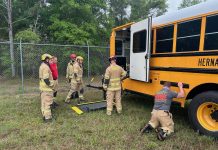WASHINGTON, D.C. — The American School Bus Council (ASBC) and National Highway Traffic Safety Administration (NHTSA) recently unveiled new tools that will be used by ASBC members to help promote student ridership on large school buses.
“As a public health and safety agency we are committed to safety and ensuring children and teens get from place to place in the safest ways possible,” said NHTSA Administrator David Strickland. “Although no mode of transportation is completely without risk, school buses continue to be the safest way to transport students to and from school — significantly safer than walking, riding a bicycle or being driven to school in a car.”
According to NHTSA data, each year approximately 700 school-aged children are killed in motor vehicle crashes during normal school travel hours. Only four percent involve school buses. Meanwhile, the remaining 96 percent involve passenger vehicles, pedestrians, bicyclists, motorcyclists or other types of vehicles.
The tools announced in October include educational handouts, sample public service announcements and tools for use on social networks and websites. These tools are designed to reach parents and caregivers and students age 13 to 18.
“It may not be ‘cool’ to ride to high school in a school bus, but it’s significantly safer than riding in a car with a teen driver at the wheel,” said Michael Martin, executive director of the National Association for Pupil Transportation (NAPT) and one of the six founding members of ASBC. “Riding the school bus is also an easy way for teens to save on gas money. And fewer teen drivers on the road also reduces emissions and traffic congestion during rush hours.”
According to ASBC, school buses remove some 17.2 million cars off the road each morning and afternoon, and the average school bus replaces 36 cars that each would travel about 3,600 miles a year. This translates into saving 4,800 gallons of gas, per bus per year, or an annual savings of 2.3 billion gallons of fuel. To view these fact sheets, check out NSTA’s website link here.
“Most people are familiar with the school bus because it’s an American icon that’s a critical part of our public education system. But much has changed in our society, including the role of the school bus,” said Bob Riley, ASBC member and executive director of the National Association of State Directors of Pupil Transpiration Services (NASDPTS). “Not only is it the safest, but it’s also the smartest, most efficient and convenient way for most young people to get to and from school.”
The American School Bus Council is a coalition of organizations committed to providing safe, effective, efficient and healthy transportation to and from school each day.















